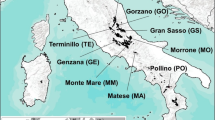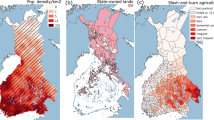Abstract
Intense harvesting and slash fires during the late 1800s and early 1900s led to homogenization throughout the Great Lakes region via the conversion from tamarack, pine, and spruce forests to aspen forests, which are supported by the forest products industry. Subsequently, mesophication occurred in the eastern United States due to fire suppression, transforming oak woodlands to mixed mesophytic forests. We explored both homogenization and mesophication at a regional scale by quantifying changes in community composition and density between historical General Land Office survey points and current USDA Forest Analysis and Inventory plots for Minnesota’s Laurentian Mixed and Eastern Broadleaf Forest provinces. We used the Morisita plotless density estimator and applied corrections for surveyor bias to estimate density for historical forests and we used known densities of FIA plots to predict current densities with random forests, an ensemble regression tree method, and terrain and soil predictor variables. Of the 43 ecological units used in the analysis, only one current community was similar to its historical counterpart. Within the Laurentian Mixed Forest province, forest density of primarily mature aspen stands is reduced slightly today compared to the tamarack-dominated forests of the past. Conversely, in the Eastern Broadleaf Forest province, forest densities have increased compared to historical pine and oak woodlands, due to increases of densely growing, fire-sensitive species. Ordinations of functional traits and structure showed substantial changes between current and historical communities as well as reduced differentiation among current communities compared to their historical counterparts. Homogenization in the Laurentian Mixed Forest is occurring by transition from early-successional to late-successional species, with associated changes in forest ecosystems, and homogenization and mesophication in the Eastern Broadleaf Forest are occurring by transition from disturbance-stabilized genera of open forest ecosystems to non-disturbance-dependent genera of dense forests. Despite different starting points of historical forest ecosystems in the Laurentian Mixed Forest and Eastern Broadleaf Forest, we found homogenization and mesophication to be interrelated in the convergence of composition and densities along a common trajectory to dense forests composed of late-successional species in Minnesota.






Similar content being viewed by others
References
Abrams MD (1990) Adaptations and responses to drought in Quercus species of North America. Tree Physiol 7:227–238
Allen CD, Macalady AK, Chenchouni H, Bachelet D, McDowell N, Vennetier M, Kizberger T, Rigling A, Breshears DD, Hogg EH, Gonzalez P, Fensham R, Zhang Z, Castro J, Demidova N, Lim JH, Allard G, Running SW, Semerci A, Cobb N (2010) A global overview of drought and heat-induced tree mortality reveals emerging climate change risks for forests. For Ecol Manage 259:660–684
Andersson M, Milberg P, Bergman K-O (2011) Low pre-death growth rates of oak (Quercus robur L.)—is oak death a long-term process induced by dry years? Ann For Sci 68:159–168
Auclair AND, Lill JT, Revenga C (1996) The role of climatic variability and global warming in the dieback of northern hardwoods. Water Air Soil Pollut 91:163–186
Beers TW, Dress PE, Wensel LC (1966) Aspect transformation in site productivity research. J For 64:691–692
Bergeron Y, Brisson J (1990) Fire regime in red pine stands at the northern limit of the species’ range. Ecology 71:1352–1364
Breiman L (2001) Random forests. Mach Learn 40:5–32
Cleland DT, Avers PE, McNab WH, Jensen ME, Bailey RG, King T, Russell WE (1997) National hierarchical framework of ecological units. In: Boyce MS, Haney A (eds) Ecosystem management applications for sustainable forest and wildlife resources. Yale University Press, New Haven, pp 181–200
Cole KL, Davis MB, Stearns R, Guntenspergen G, Walker K (1998) Historical land cover changes in the Great Lakes Region. In: Sisk TD (ed) Perspectives on the land-use history of North America: a context for understanding our changing environment. US Geological Survey, Biological Resources Division. Biological Science Report USGS/BRD/BSR 1998-0003, Springfield, pp 43–50
Crow TR (1988) Reproductive mode and mechanisms for self-replacement of northern red oak (Quercus rubra)—a review. For Sci 34:19–40
Cutler DR, Edwards TC Jr, Beard KH, Cutler A, Hess KT, Gibson J, Lawler JJ (2007) Random forests for classification in ecology. Ecology 88:2783–2792
Díaz S, Cabido M (2001) Vive la différence: plant functional diversity matters to ecosystem processes. Trends Ecol Evol 16:646–655
Foster DR, Motzkin G, Slater B (1998) Land-use history as long-term broad-scale disturbance: regional forest dynamics in central New England. Ecosystems 1:96–119
Frelich LE, Reich PB (1995) Spatial patterns and succession in a Minnesota southern-boreal forest. Ecol Monogr 65:325–346
Frelich LE, Reich PB (2010) Will environmental changes reinforce the impact of global warming on the prairie-forest border of central North America? Front Ecol Environ 8:371–378
Frey BR, Lieffers VJ, Hogg EH, Landhäusser SM (2004) Predicting landscape patterns of aspen dieback: mechanisms and knowledge gaps. Can J For Res 34:1379–1390
Friedman SK, Reich PB (2005) Regional legacies of logging: departure from pre-settlement forest conditions in northern Minnesota. Ecol Appl 15:726–744
Fuller JL, Foster DR, McLachlan JS, Drake N (1998) Impact of human activity on regional forest composition and dynamics in central New England. Ecosystems 1:76–95
Galatowitsch S, Frelich L, Phillips-Mao L (2009) Regional climate change adaptation strategies for biodiversity conservation in a midcontinental region of North America. Biol Conserv 142:2012–2022
Goslee SC, Urban DL (2007) The ecodist package for dissimilarity-based analysis of ecological data. J Stat Softw 22:1–19
Grimm EC (1983) Chronology and dynamics of vegetation change in the prairie-woodland region of southern Minnesota, U.S.A. New Phytol 93:311–350
Haavik LJ, Stahle DW, Stephen FM (2011) Temporal aspects of Quercus rubra decline and relationship to climate in the Ozark and Ouachita Mountains, Arkansas. Can J For Res 41:773–781
Hanberry BB, Fraver S, He HS, Yang J, Dey DC, Palik BJ (2011) Spatial pattern corrections and sample sizes for forest density estimates of historical tree surveys. Landscape Ecol 26:59–68
Hanberry BB, Yang J, Kabrick JM, He HS (2012) Adjusting forest density estimates for surveyor bias in historical tree surveys. Am Midl Nat 167:285–306
Kabrick JM, Dey DC, Jensen RG, Wallendorf M (2008) The role of environmental factors in oak decline and mortality in the Ozark Highlands. For Ecol Manage 255:1409–1417
Klos RJ, Wang GG, Bauerle WL, Rieck JR (2009) Drought impact on forest growth and mortality in the southeast USA: an analysis using Forest Health and Monitoring data. Ecol Appl 19:699–708
Kulakowski D, Veblen TT, Drinkwater S (2004) The persistence of quaking aspen (Populus tremuloides) in the Grand Mesa Area, Colorado. Ecol Appl 14:1603–1614
Liaw A, Wiener M (2002) Classification and Regression by randomForest. R News 2:18–22
McCune B, Cottam G (1985) The successional status of a southern Wisconsin oak woods. Ecology 66:1270–1278
McKinney ML, Lockwood JL (1999) Biotic homogenization: a few winners replacing many losers in the next mass extinction. Trends Ecol Evol 14:450–453
Mladenoff DJ, Stearns F (1993) Eastern hemlock regeneration and deer browsing in the Northern Great Lakes region: a re-examination and model simulation. Conserv Biol 7:889–900
Morisita M (1957) A new method for the estimation of density by the spacing method, applicable to non-randomly distributed populations. Seiri Seitai 7:134–144 (in Japanese)
Mueller-Dombois D (1987) Natural dieback in forests. Bioscience 37:575–583
Niinemets Ü, Valladares F (2006) Tolerance to shade, drought, and waterlogging of temperate northern hemisphere trees and shrubs. Ecol Monogr 76:521–547
Nowacki GJ, Abrams MD (2008) The demise of fire and ‘mesophication’ of forests in the eastern United States. Bioscience 58:123–138
Nuzzo VA (1986) Extent and status of Midwest oak savanna: presettlement and 1985. Nat Area J 6:6–36
Olden JD, Rooney TP (2006) On defining and quantifying biotic homogenization. Glob Ecol Biogeogr 15:113–120
Oswald WW, Faison EK, Foster DR, Doughty ED, Hall BR, Hansen CS (2007) Post-glacial changes in spatial patterns of vegetation across southern New England. J Biogeogr 34:900–913
Palik BJ, Pregitzer KS (1992) A comparison of presettlement and present-day forests on two bigtooth aspen-dominated landscapes in northern lower Michigan. Am Midl Nat 127:327–338
Pinto F, Romaniuk S, Ferguson M (2008) Changes to preindustrial forest tree composition in central and northeastern Ontario, Canada. Can J For Res 38:1842–1854
R Development Core Team (2010) R: a language and environment for statistical computing. R Foundation for Statistical Computing, Vienna
Rogers DA, Rooney TP, Olson D, Waller DM (2008) Shifts in southern Wisconsin forest canopy and understory richness, composition, and heterogeneity. Ecology 89:2482–2492
Sappington JM, Longshore KM, Thompson DB (2007) Quantifying landscape ruggedness for animal habitat analysis: a case study using bighorn sheep in the Mojave Desert. J Wildl Manag 71:1419–1426
Schulte LA, Mladenoff DJ, Crow TR, Merrick LC, Cleland DT (2007) Homogenization of northern U.S. Great Lakes forests due to land use. Landscape Ecol 22:1089–1103
Shenoy A, Johnstone J, Kasischke E, Kielland K (2011) Persistent effects of fire severity on early successional forests in interior Alaska. For Ecol Manage 261:381–390
Stambaugh MC, Guyette RP, McMurry ER, Cook ER, Mekoc DM, Lupod AR (2011) Drought duration and frequency in the U.S. Corn Belt during the last millennium (AD 992–2004). Agric For Meteorol 151:154–162
Swetnam TW, Betancourt JL (1998) Mesoscale disturbance and ecological response to decadal climatic variability in the American Southwest. J Clim 11:3128–3147
Thomas FM, Blank R, Hartmann G (2002) Abiotic and biotic factors and their interactions as causes of oak decline in Central Europe. Forest Pathol 32:277–307
White CA (1983) A history of the rectangular survey system. Bureau of Land Management, Washington, DC
White MA, Mladenoff DJ (1994) Old-growth forest landscape transitions from pre-European settlement to present. Landscape Ecol 9:191–205
Worrall JJ, Marchetti SB, Egeland L, Mask RA, Eager T, Howell B (2010) Effects and etiology of sudden aspen decline in southwestern Colorado, USA. For Ecol Manage 260:638–648
Zhang Q, Pregitzer KS, Reed DD (2000) Historical changes in forests of the Luce District of the Upper Peninsula of Michigan. Am Midl Nat 143:94–110
Acknowledgments
We thank anonymous reviewers for their suggestions. We received funding from the National Fire Plan, USDA Forest Service.
Author information
Authors and Affiliations
Corresponding author
Electronic supplementary material
Below is the link to the electronic supplementary material.
Rights and permissions
About this article
Cite this article
Hanberry, B.B., Palik, B.J. & He, H.S. Comparison of historical and current forest surveys for detection of homogenization and mesophication of Minnesota forests. Landscape Ecol 27, 1495–1512 (2012). https://doi.org/10.1007/s10980-012-9805-5
Received:
Accepted:
Published:
Issue Date:
DOI: https://doi.org/10.1007/s10980-012-9805-5




